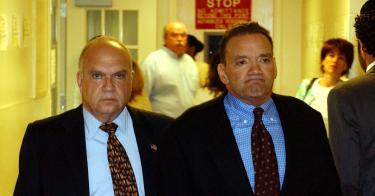Even by Hollywood standards, school district fraud can be dramatic.
As the new HBO film Bad Education chronicles, Roslyn, New York, School Superintendent Frank Tassone led an embezzlement scheme that siphoned off some $11 million meant for students. For more than six years, he and his assistant superintendent, Pamela Gluckin, lived the high life. Meanwhile, the school board remained blissfully ignorant of the criminal activity committed by its highest-paid employees.
Roslyn is notable, but not unique. As political scientist Terry Moe chronicles in The Politics of Institutional Reform: Katrina, Education, and the Second Face of Power, before they were closed by Hurricane Katrina and then replaced by charter schools, New Orleans public schools were so corrupt that the FBI had an office in the district’s administration building.
The bureau notched nearly 30 convictions, including that of a former school board president who pocketed over $140,000 in bribes. As Peter Burns and Matthew Thomas note in Reforming New Orleans, one enterprising administrator actually granted a large contract to repair fire damage to a school a month before the fire occurred.
One of us is a former charter school district administrator; the other has served on both charter and traditional public school boards. We know from experience that the vast majority of public educators are honest and that few school districts have Roslyn- or New Orleans-level chicanery. But we also know that public school corruption is common, with perpetrators rarely held accountable.
Over the years, Department of Education inspector general reports have said that the office receives more reports of misdeeds than it can investigate. In Chicago, the school district investigator only investigates 25-30% of the reports it receives every year, citing capacity issues. Chicago’s office received more than 2,000 such claims in 2019.
Here are things we have either seen (and never made the media or court dockets) or found in research:
- Illegally recruiting star athletes from outside the district by getting their families jobs, or even houses, and then failing to report when those same athletes misbehave.
- Creatively manipulating official measures such as graduation rates and absenteeism.
- Allowing those accused of sexual harassment to resign quietly and find jobs in other school districts rather than face public discipline.
- Allowing embezzlers to resign quietly and find jobs in other school districts rather than calling the cops.
- Misusing personnel systems to employ the relatives or lovers of administrators rather than the best educators.
Two key conditions enable corruption.
First, education intellectuals avoid researching public school corruption; some prefer cover-ups to clean-ups. For example, in Fertilizers, Pills, and Magnetic Strips, Gene Glass writes approvingly that corrupt acts in public schools “are usually dealt with in subtle ways that protect the dignity of the individuals involved while protecting the integrity of the school.” We see this phenomenon in Bad Education when Tassone and the Roslyn school board ask Gluckin to resign and claim she has cancer—all before Tassone’s involvement was uncovered. While the writers took some creative liberties with the story, our experiences suggest the example rings true in real-life situations.
Second, though the vast majority of school board members are honest, the nation's 13,500 district school boards could do far more to ferret out corruption. In some states, school board training is run in cooperation with school administrator associations, so few board members gain the expertise needed to hold administrators accountable, or even comprehend schools’ complex budgets. Further, mandated audits are designed to find moneys spent out of category, not misspending within categories. Investigators often uncover incidents of fraud in school districts that have already been warned that their accounting practices do not comply with industry standards, warnings of which school boards should be aware.
These conditions allow school district fraud to persist for years, as in the cases of Tassone, former Baltimore County Superintendent Dallas Dance, and former Chicago Superintendent Barbara Byrd-Bennett.
K-12 spending accounts for one-quarter to half of state budgets, and many interest groups are pushing for a mega-billion dollar federal bailout to make up for the coronavirus revenue slump. If Congress decides to spend this money, lawmakers should at least condition aid on reforms to promote ethics. Those could include changing school financing laws to foster simplicity and transparency and encouraging the creation of state- or district-level inspectors general for schools. Meanwhile, state lawmakers should create more public and private learning options for students and allow parents to vote with their feet by leaving districts beset with problems.
Of course, for any of this to happen, policymakers must acknowledge that school fraud is real and very debilitating. To that end, Bad Education offers a valuable lesson.
This piece originally appeared in the Washington Examiner




